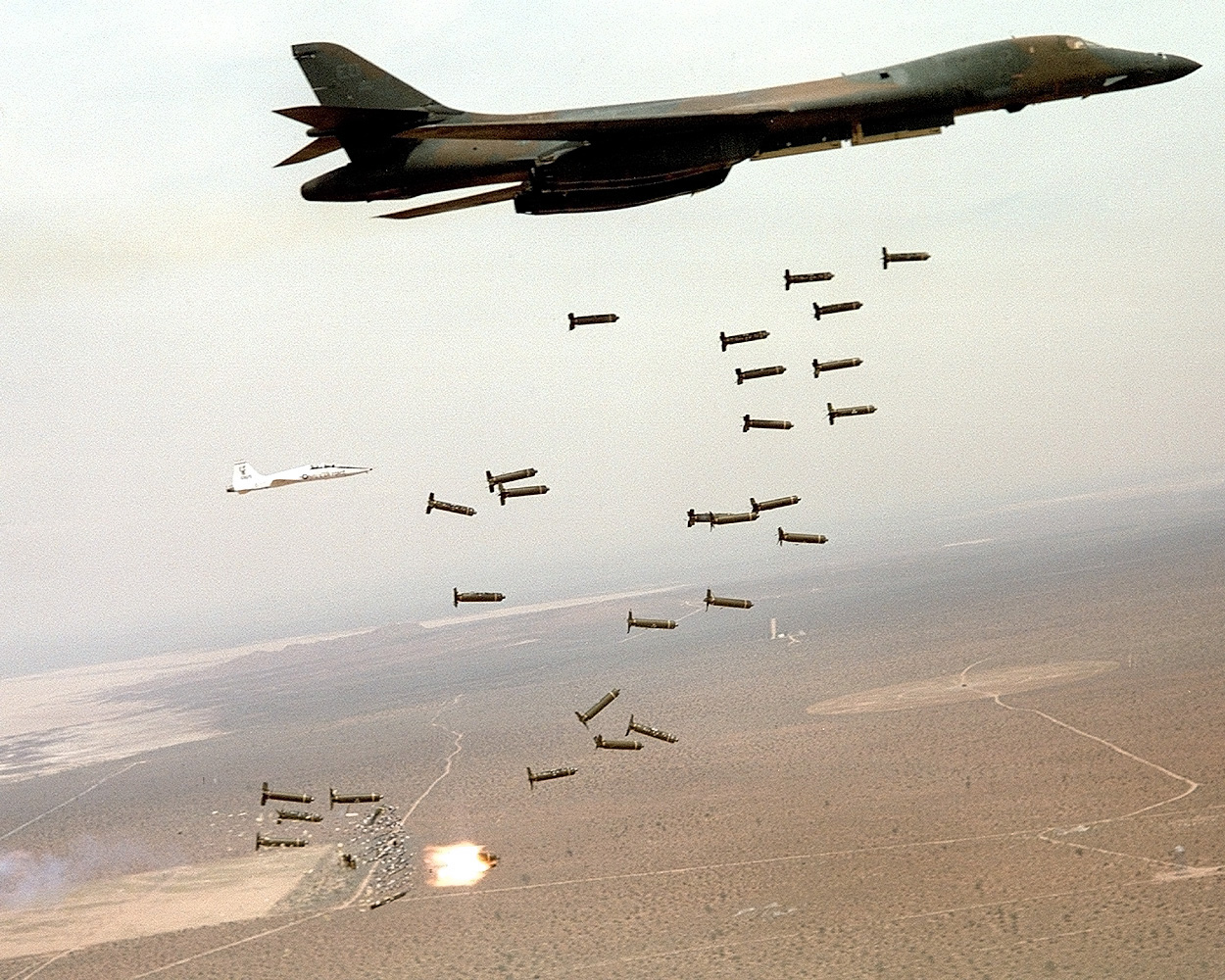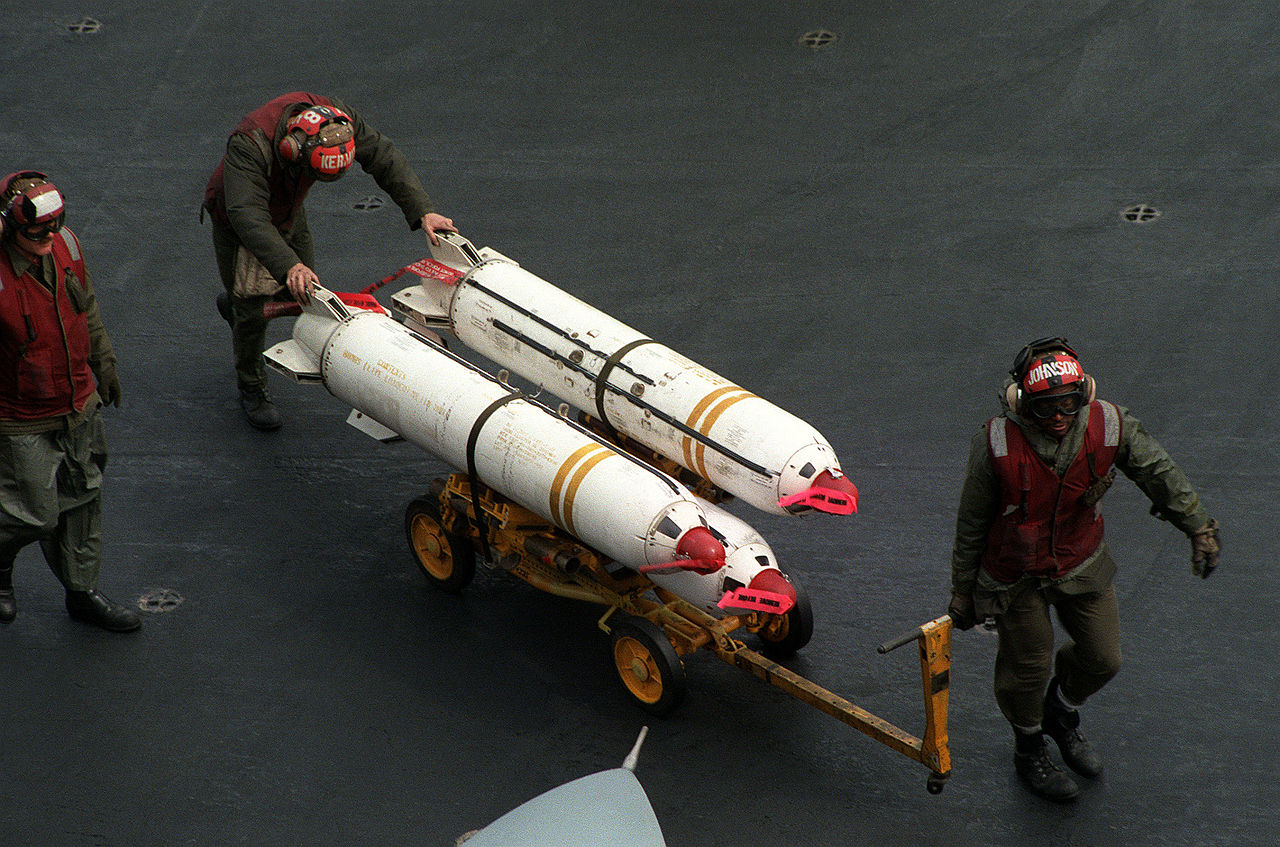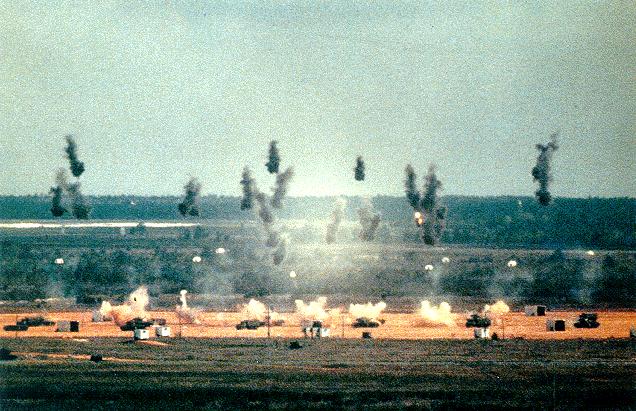The damage of an explosion doesn’t scale linearly with size. The general rule of thumb is that the radius for a given amount of damage scales with the cube root of the weight of the explosive charge. This means that trying to destroy a larger area by just making bigger bombs has sharply diminishing returns. It’s much more efficient to drop multiple smaller bombs, particularly on soft targets like trucks and troops in the open. Taking this to its logical conclusion, the best way to destroy a soft area target is to drop dozens or hundreds of small bomblets on it. The easiest way to do this is to package a cluster of bomblets into something that can be handled and used more or less like a normal bomb, and these devices were soon dubbed cluster bombs.

A B-1B dropping cluster bombs
The first cluster bombs were developed before WWII, primarily to carry incendiary bomblets.1 Incendiaries are particularly well-suited to cluster deployment, as starting a fire is fairly easy if the bomb lands in the right place, and cluster bomblets multiply both opportunities to land in the right place and the problems of firefighters trying to contain the resulting blaze. The Soviets used an early version of this in the Winter War with Finland, with Foreign Minister Vyacheslav Molotov claiming that they were dropping food to starving Finns. The Finns, who were not starving, dubbed the devices Molotov bread baskets, and later said that they were giving the Soviets drink to go with the food when they improvised incendiaries from bottles, creating the Molotov cocktail.
The Germans pioneered the use of explosive cluster munitions with the "Butterfly Bomb", named after the "wings" that deployed to arm it while it fell. When used with contact fuzes, these were deadly to exposed troops, but the real danger was when they were set to hit the ground and sit harmlessly for a while. Some were fitted with time fuzes, intended to hinder firefighting and rescue operations after the air raid. Others were set to go off only when disturbed or tampered with, which tended to be even more hazardous during cleanup. Even today, WWII-era bomblets turn up from time to time, and have to be blown up in place.

Rockeye cluster bombs are loaded on the USS Saratoga, 1986
In the aftermath of WWII, development of cluster bombs moved into high gear. Chemical and biological weapons were favorite candidates, as cluster bombs were ideal for dispersing them evenly across a large area. The payloads considered ranged from smoke and tear gas all the way to Sarin, VX, and various anti-crop diseases. Fortunately, none of these were ever used operationally, and all have been destroyed. Other bomblets were developed to attack vehicular targets, even tanks. These usually consisted of a bomblet containing a shaped charge and designed to fall so that it would hit the top of the target and fire a jet of hypersonic metal through it. More sophisticated mines were designed, capable of extending tripwires, and even rendering themselves safe after a certain time.
Cluster bombs proved valuable in Vietnam, prompting development of another generation of these weapons, many of which remain in the US arsenal. The standard USAF cluster bomb is the CBU-87 Combined Effects Munition, which is loaded and dropped like any other bomb. After launch, it starts spinning, at a rate which, combined with the altitude set into its proximity fuze, determines the area covered. When it finally goes off, it releases 202 submunitions, each of which has a shaped charge for destroying vehicles and equipment, a scored steel fragmentation case to kill personnel and a zirconium ring for incendiary effect.

CBU-97 skeets detonate over a target
The late 80s and early 90s saw more innovation, this time aimed at reducing the collateral damage done by cluster bombs. The most prominent is the CBU-97 Sensor Fuzed Weapon, which ejects 40 "skeets" the size of a hockey puck. Each "skeet" is capable of detecting and classifying targets on the ground below, then firing an explosively formed penetrator through the highest-priority one. It's a fantastic weapon for eliminating an armored formation or other concentration of enemy vehicles. Other new weapons include the CBU-94, which ejects submunitions filled with graphite filaments. If dropped over a power station, these will short out electrical equipment, disabling the local power grid with minimal danger to life. Another, designed to remove the danger of unexploded ordnance, is the CBU-107, which is filled with thousands of steel and tungsten rods that rain down on the target area at high speed.
During the 90s, the Air Force decided to make use of the same technology that powered JDAM to improve its cluster bomb inventory. Because cluster bombs are inherently area weapons, JDAM-level accuracy wasn't necessary, so the resulting kit, known as Wind-Corrected Munition Dispenser (WCMD) was set by the GPS on the launch platform, then relied on inertial guidance after release. This was still good enough to get it within 30m or so of the desired impact point, and WCMD shares many of JDAM's other features, such as the ability to steer an energy-efficient course to the target, giving the launch aircraft more standoff and thus more options.
15 years ago, cluster bombs were an important part of the American military arsenal, but they're almost obsolete today. The problem is that cluster bombs have a tendency to leave lots of unstable and very dangerous bomblets scattered across the landscape, even when they're not supposed to do so. Larger bombs have sophisticated fuzes to accomplish the twin purposes of making sure they don't go off when they aren't supposed to (like when they're attached to the aircraft) and that they do go off when they are supposed to (like when they hit the ground). Because the first is much worse than the second from the operator's point of view, designers obviously tend to favor it, but when the fuze has to be miniaturized to fit into a bomblet weighing maybe 4 lb while leaving room for the actual payload, the dud rate of submunitions tends to be pretty high. Something like a CBU-87 generally has a 5% dud rate, which means that it will leave 10 bomblets scattered about the landscape. This is a problem even if whoever finds them calls a bomb disposal team, as the bomblets are unstable and need to be blown up in place. It's much worse if whoever finds one doesn't realize what it is and decides to mess with it. Over 100 countries have agreed to ban all cluster munitions, and while the US isn't among them, it has announced a plan to make sure all cluster munitions used going forward have a dud rate under 1%.
But all of the weapons discussed so far require the launching aircraft to get quite close to the target. This can be quite unhealthy, depending on the state of enemy air defenses, and we'll start looking at standoff weapons, designed to avoid this problem, next time.
1 The bomblets themselves were developed during WWI, but initially they were just dropped from a basket on the airplane and fell independently. Loading them into a bomb/dispenser made it easier to control their spread and make sure the density is right. ⇑

Comments
I'm extremely curious about the targeting systems of these skeets, particularly since at the time they were developed there wouldn't have been very much in the way of computing hardware to throw at the task. I imagine there are some very clever hacks at work to produce the desired outcome.
This was surprisingly difficult to figure out, but I managed to do it. The initial BLU-108s had a two-color IR sensor, while later versions added a laser profile measurement system. A lot of sources don't distinguish between the two. And I'm very sure that there's a lot of cleverness in the design, although I obviously don't have details.
The primary sensor on the "skeet" was an infrared system looking for abrupt transitions to either higher or lower IR emission than the ambient environment. Even if the engine isn't running, large metal objects often(*) have substantially different thermal behavior than their surroundings. The aimpoint of the sensor leads that of the penetrator, so if the sensor reads "cool-warm-cool" (or vice versa) over say three meters with a sharp edge on each side, a brief delay will put the penetrator in the middle of the warm (or cool) thing.
There were secondary sensors to reduce the false alarm rate and the susceptibility to cheap countermeasures, but I'm less familiar with those.
The sensor on even the early units was a dual-color one, which is probably how they did most of the countermeasures. (A vehicle and a campfire may look similar in some types of IR, but they'll look very different in others, and if you mix them right, you can get surprising discrimination.
With regard to unexploded ordnance, I imagined that the sheer number of bomblets was part of the problem. If you drop 200 small bombs rather than one large one you'll have a lot more duds even if the failure rate is the same. How much less effective against a given target (say infantry and mixed soft skinned and armoured vehicles) is the 107 than the 87? It sounds like it would be pretty cheap to manufacture, but might be ineffective when released at low altitude.
Some of the EOD problem is the sheer number of weapons. Some is restrictions on size/cost, which reduces reliability of the fuze.
I'm still not sure why the 107 hasn't seen more use. It was apparently developed to attack chemical and biological storage facilities, although it was obviously used against different targets in Iraq. It's going to be problematic against personnel targets because of flechette density issues. Should work decently against vehicles.
What aspect of "damage" do you mean when you say that its radius scales as the cube root of the explosive charge?
I can see a justification for peak overpressure to behave this way: energy density or integrated overpressure in the shock front scales as r^-2, and the width of the shock will increase as it propagates (linearly with time?), which might reasonably give the peak overpressure an r^-3 dependence. But I'd expect cluster bombs to depend on shrapnel for their effect, and I'm not sure how to justify shrapnel behaving the same way.
Are duds completely random or are there environmental effects on the probability of not detonating.
Because if it's completely random, you can drop from 5% duds to 0.25% just with some superglue.
I suppose what I'm saying is that if you drop 100 3kg bombs, that's almost as effective as 200 1.5kg bombs but you have more weight budget to make sure it won't kill any civillians 10 years down the line.
Though I'm not sure how happy I am about leaving on average 1 or 2 bomblets as UXO per cluster bomb, which is what 1% gives you. And I hope that 1% isn't just measured under perfect temperature/humidity conditions.
@doctorpat
That's the general rule of thumb when analyzing bombs. I can't recall what the exact physical basis is, and there are obviously different types of damage that scale differently. All of them have exponents less than one, so you're still going to get lots of small explosions as your most efficient case.
@Lambert
There might be an environmental factor, but the US military is pretty good about checking that kind of thing, so I doubt it's huge. Bigger bomblets help, although with something like Combined Effects Munitions you do need to make sure that some bomblets actually land on the vehicles you want to destroy.
@bean The critical exponent is -2 (i.e. "damage" goes down as r^-2). At this value, you damage the same total ground area whether you use one big bomb or lots of little ones. The thermal pulse from a nuclear bomb, for example, has this exponent.
I'm sure this falls into the category of "it depends how you use it" as well as which weapon we're talking about, but what are the order of magnitude spatial densities and coverage area that cluster munitions are capable of?
@DampOctopus
I'm not sure that's right. Nuclear weapon thermal radius scales with yield^(1/3) IIRC, which means you're going to get more damage out of an equivalent yield of smaller weapons. This is pretty much always the case for any weapon I'm aware of.
@redRover
CBU-87, depending on spin rate and release altitude, can cover anything from a 20m x 20m area to a 120m x 240m area.
Maybe there's some kind of attenuation term so actually flux=r^-2*e^-ar and they pretend the exponential term is nonlinear because pretending nonlinear stuff is linear is a big part of what engineers do.
Though the Taylor expansion doesn't really check out.
@bean @Lambert There are plenty of online calculators etc., but I'm having trouble finding a good source for these scaling relations. As a quick-and-dirty check, if I take this table and work out the corresponding power laws (comparing the 1kt vs 1Mt columns, using the first line for each effect, and ignoring the difference in burst height), I get r^-2.8 for the blast wave, r^-2.3 for the thermal pulse, and r^-6.5 for ionising radiation. So I was wrong to give the exponent as -2 for the thermal pulse, but it's closer to that case than the ~-3 for the blast wave.
I like Lambert's explanation in terms of attenuation. Expanding as a first-order Taylor series, r^-2 * e^-ar = r^-2 / e^ar ~= r^-2 / (1+ar), which will be ~r^-2 or ~r^-3/a depending on which regime you're in. The blast wave and thermal pulse cases are in this range, whereas the ionising radiation is apparently so highly attenuated that the first-order approximation isn't valid.
Conventional bombs aren't nukes. Their blast might or might not fall off in a nuke-like manner (Googling indicates R^-3 exponent there) while fragments are somewhere between R^-2 and R^-1. Which indicates that for pure fragmentation effects, you're better off with a bigger conventional bomb. If this is the case (I have better references, but don't have time to look them over now) then cluster bombs make sense if you're looking at non-fragment damage mechanisms, which you often are. The CBU-87 submunitions are fragmentation, but also have shaped-charge warheads and the incendiary ring, and neither of those are going to work nearly as well coming from a unitary weapon.
Actually, I suspect that cluster fragmentation is also going to benefit from dispersal. Yeah, a 1000-lb cluster bomb and a Mk 83 may in theory have the same lethal fragmentation area, but that assumes that there's no cover. A single bomb is going to leave a lot of its theoretical area uncovered because something heavy was in the way. A proxy-fuzed airburst will help, but a cluster bomb is going to have lots of fragments coming from all directions, which makes cover a lot more difficult to find.
@Bean,
Off topic, but you replied to my comment even though I didn't post it.
I started to write about explosion scaling, realized I didn't have the time right then to do the math to give the subject justice, so I cancelled the comment without posting.
But you got the half formed comment anyway. Gives some insight to the code underlying this website.
Huh. That's very weird, particularly as it's gone now. I sometimes have no clue.
@bean Regarding the scaling of fragments, my first thought is that they should fall off as r^-2 (based on a constant number of fragments passing through successively larger spheres) or faster (if you allow for drag, decreasing their speed). On further thought, though, I can see how you can get r^-1 scaling, if the fragmentation pattern is directional, and restricted (roughly) to two dimensions: think of the directionality of an M18 Claymore, or the annular blast pattern of an AAM.
This sort of scaling is only important when you're in the regime of "get the bomb within X of the target" rather than "hit the target directly", which favours cluster munitions. Shaped charges and incendiaries work in the latter regime: you want to (e.g.) land directly on something flammable, so you want as many tiny bomblets as you can get. Your last example is a bit like this: "get at least one fragmentary submunition within the piece of cover the enemy is using".
I've had a look, and can't find anything more on basic scaling laws than I had above, although it was confirmed by my copy of Weapon Systems Fundamentals. There's a lot of detail in various books, but it's mostly really complicated stuff for engineering analysis. AMCP 706-290 looks the closest to what I want, but the copy I have is too blurry for me to read all of the equations. I may see if I can find a better copy at some point.